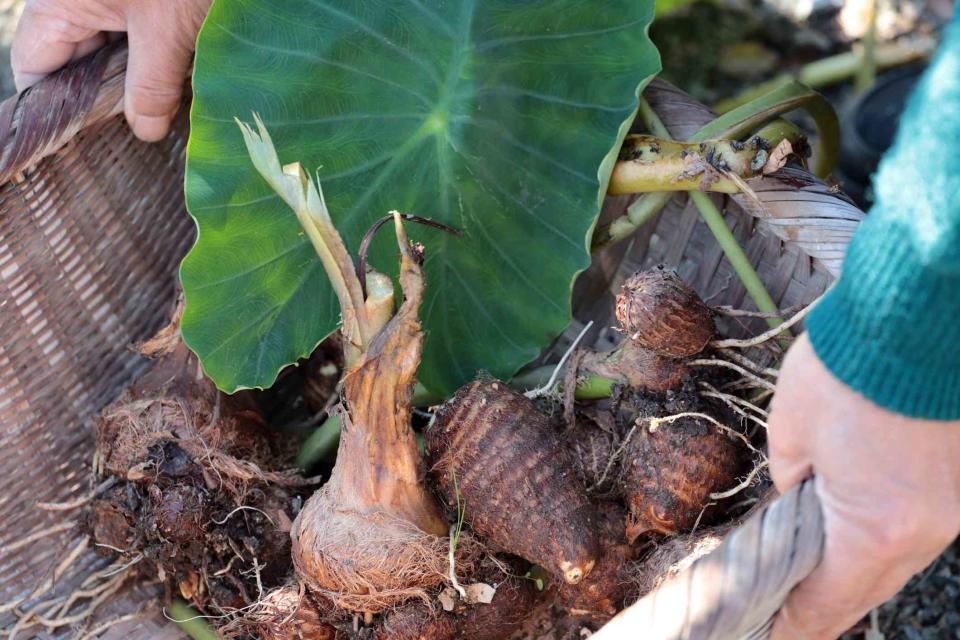How to Plant Elephant Ear Bulbs Correctly for a Tropical Garden Oasis
Plant these for a lush, tropical look in your garden

Eriko Koga / Getty Images
Elephant ears, also known as alocasias and colocasias, are easily recognized by their large, heart-shaped leaves and are loved for their range of color and dramatic foliage. These tropical plants are beautiful on their own, indoors or outdoors, or pair well with other summer plants outside.
If you’re looking to add elephant ears to your greenery collection, follow these tips on how to plant elephant ear bulbs to ensure your plants are set up to thrive.
How to Plant Elephant Ear Bulbs
Add compost or mulch to the soil area to increase soil nutrients and organic matter.
Loosen the soil about 8 inches deep, removing any stones or grass. Level the surface with a rake.
Dig holes about 5 inches deep and 3 feet apart.
Place the bulb in the soil. The top of the bulb should be about 1 inch below the soil surface.
Cover the bulb with soil and water thoroughly.
Tip
Not sure which direction the bulb should go in the earth? Sometimes it’s not so obvious. Elephant ear bulbs typically have a smooth side and a rougher, bumpier side with signs of root hairs. Plant the bulbs smooth side up (this side may also have a pointy tip).
When to Plant Elephant Ear Bulbs
Plant elephant ears when temperatures have warmed up in the spring and any danger of frost has passed. Elephant ear bulbs will not grow in cold soil, so wait until the soil temperature reaches 65ºF.
If you’re hoping to get a jump start on planting, you can plant the bulbs in pots indoors about four to six weeks before you transfer them outside.
Where to Plant Elephant Ear Bulbs
Elephant ears need lots of room once they mature, so select a spot that allows at least 3 feet of space for each bulb to grow in a partially shaded area. Too much sun can scorch the leaves. The exception to this is the Black Magic variety of elephant ears, which does well in partial to full shade.
If you plant the elephant ear plant indoors, select a spot that has bright, filtered sunlight.
Make sure the soil where the bulbs are planted is well-draining and rich in organic matter. You can add compost or mulch to the soil to give it an extra boost of nutrients.
How to Take Care of Elephant Ear Bulbs After Planting
Water: Elephant ears thrive in moist soil, so it’s important to water the bulbs regularly. Wait until the top inch of soil is dry before watering again, and plan on giving the plants at least 2-3 inches of water per week.
Feeding: These plants also benefit from fertilizer every three to four weeks. Choose a fertilizer high in nitrogen to promote the most growth.
Pruning: If you notice wilting or browning leaves, remove them by cutting leaves off at the base of the plant.
Winter care: Unless you live in an area that has warm temperatures year-round, elephant ear bulbs will need to be stored indoors before temperatures dip below 40ºF. At the end of the season, cut back the leaves, dig up the bulbs, and store them in a cool, dry place until planting next spring.
How Long Does It Take Elephant Ear to Grow from Bulbs?
Elephant ears can take some time after planting to grow. Depending on your climate, it usually takes three to eight weeks for elephant ears to sprout. Warmer temperatures will cause elephant ears to sprout faster than cooler climates.
Frequently Asked Questions
Should I start my elephant ear bulbs indoors?
If you live in an area with long winters, you may want to get a head start on your elephant ear plant by planting the bulbs in pots indoors. Plant them about four to six weeks before transferring outside when there is no risk of frost and the soil temperature reaches 65ºF.
Should I soak elephant ear bulbs?
Water the soil thoroughly after planting elephant ear bulbs. The bulbs need to be kept moist, but avoid soaking or overwatering since this can cause root rot. A good general rule is to wait until the first inch of topsoil has dried before watering again.
Do elephant ears bulbs multiply?
Elephant ear plants easily multiply and can spread through underground runners, which send up baby plants. This is especially common in warmer climates where the plants are perennials. Separate the babies from the parent plant by digging carefully around the baby plant to locate the roots and then lift the plant out of the soil to transfer to a pot or another area.
Read Next: 12 Tropical Plants You Can Grow Indoors
Read the original article on The Spruce.

